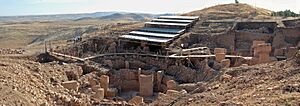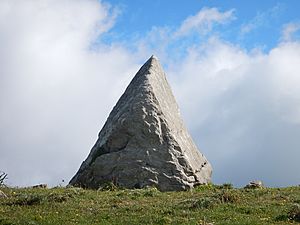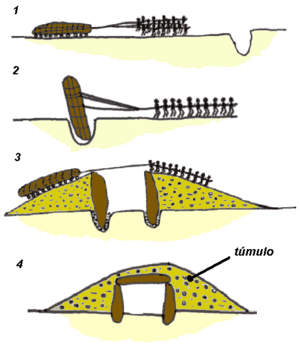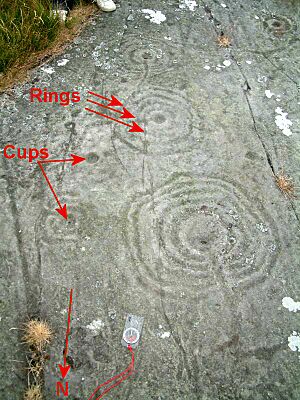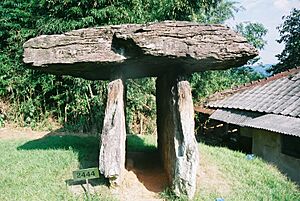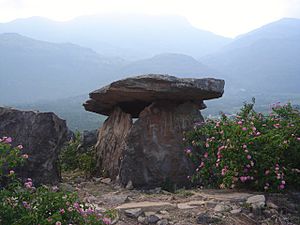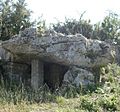Megalith facts for kids
A megalith is a very large stone used to build a structure or monument. The word comes from Ancient Greek: megas means 'great', and lithos means 'stone'. Megalithic structures are made of these big stones, put together without using mortar or cement.
People built megaliths in many parts of the world and at different times. Most were built during the Neolithic period (New Stone Age) and continued into the Bronze Age. Some even date back to the Mesolithic period (Middle Stone Age). Many megaliths were used to track important dates like the solstices (longest/shortest days) and equinoxes (equal day/night).
A very famous example of a megalithic structure is Stonehenge in England.
Contents
Ancient Stone Buildings in Turkey
In eastern Turkey, archaeologists have found very old ceremonial sites from around 9,000 BC. These places were built when people were just starting to farm and raise animals. They feature large circular buildings with huge carved stones called orthostats.
One important site is Göbekli Tepe. Here, four stone circles have been dug up, and there might be 20 more! Some of these circles are up to 30 meters (about 100 feet) wide. The stones have carvings of animals like boars, foxes, lions, birds, snakes, and scorpions, as well as human figures. These are the oldest known megalithic structures, but we don't know if they influenced later European megaliths.
Megaliths in the Middle East
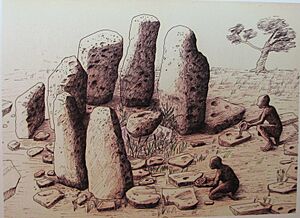
You can find dolmens (stone tables) and standing stones in many parts of the Middle East, from northern Syria all the way down to Yemen. They are common in Lebanon, Syria, Iran, Israel, Jordan, and Saudi Arabia. Many of these date back to the late Copper Age or early Bronze Age.
The largest number of dolmens are found on both sides of the Jordan Rift Valley, especially in Jordan. In Saudi Arabia, there are only a few, but they appear again in Yemen, possibly linking to traditions in Somalia and Ethiopia.
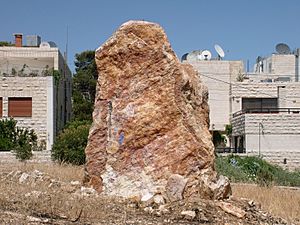
A very old example of a megalithic site was found underwater in Israel at Atlit Yam. This semicircular arrangement of stones dates back to around 7,000 BC!
Standing stones have a long history in the Middle East, going back to ancient Mesopotamian times. Some can be very tall, over 5 meters (16 feet). Even the Old Testament mentions people like Jacob and Moses setting up stones for important reasons. This tradition of honoring standing stones continued for a long time.
European Megaliths
In Europe, the most common type of megalithic building is the portal tomb. This is a chamber made of upright stones with one or more large flat stones forming a roof. Many of these tombs contain human remains, but we're not sure if burying people was their only purpose. The megalithic structures on Malta are thought to be the oldest in Europe.
Portal tombs have different names in different places, like anta in Spain, hunebed in the Netherlands, and cromlech in Wales. Most portal tombs were probably covered by mounds of earth originally.
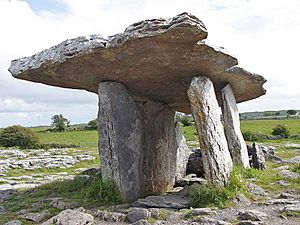
Another common type is the passage grave. These usually have a square, circular, or cross-shaped chamber with a stone roof. A long, straight passage leads into the chamber, and the whole structure is covered by a round earth mound. Famous examples include Brú na Bóinne in Ireland and Maeshowe in Orkney.
There are also gallery graves, which are long chambers under elongated mounds. Examples include the Irish court tombs and British long barrows.
Single standing stones, called menhirs, are also very common in Europe, with about 50,000 found. Some menhirs might have been used to mark astronomical events. In places like Carnac in France, you can find long and complex lines of these stones.
In Britain and Ireland, stone circles are common. Famous ones include Stonehenge and Avebury. These circles also show signs of being aligned with the sun and moon. Stonehenge, for example, is famous for its alignment with the summer and winter solstices. Stone circles are generally thought to be newer than the tombs, built during the late Neolithic and Bronze Ages.
Megalithic Tombs
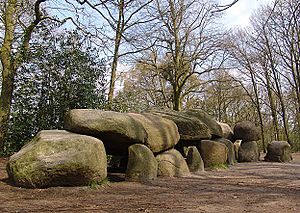
Megalithic tombs are burial chambers built above ground using large stone slabs. They were covered with earth or smaller stones. These tombs were built by farming communities mostly during the Neolithic period across Europe and nearby regions. They are different from other burial mounds because they use large stones as part of their structure.
There are many kinds of megalithic tombs. Simple dolmens found in places like Brittany, Denmark, and Ireland have a large flat stone supported by several standing stones. These were once covered by a stone pile (cairn) or earth mound (barrow).
In Italy, over 100 dolmens from the Neolithic period have been found in Sardinia. The most famous is Dolmen di Sa Coveccada. During the Bronze Age, the Nuragic civilization in Sardinia built about 800 Giants' graves, which are a type of megalithic gallery grave.
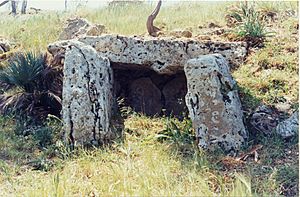
Dolmens are also in Apulia and Sicily. In Sicily, they are smaller structures, often covered by a circular earth mound. Archaeologists found human bones and pottery in the dolmen of Cava dei Servi, confirming they were used for burials.
Some tombs have extra areas not used for burial, like antechambers or forecourts. This might mean the builders wanted to show a special separation between the dead and the living.
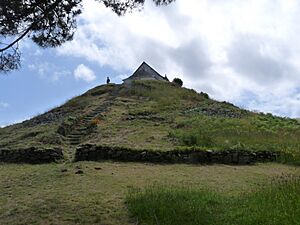
The passage graves in places like Orkney and Ireland's Boyne Valley are even more complex. The stonework at Maeshowe in Orkney is incredibly skilled for its time.
Megalithic tombs were used by communities to bury their dead over long periods, and some were even changed or made larger over time. The huge effort needed to build these structures shows that these societies cared a lot about how they treated their dead. The presence of megalithic art carved into the stones, along with pottery and animal bones found nearby, suggests that burial feasts or special rituals took place at these sites.
Other Megalithic Structures
Along with megalithic buildings in Europe, there are often large earthworks. These include ditches and banks, broad terraces, circular enclosures called henges, and artificial mounds like Silbury Hill in England.
Spirals were an important design for megalith builders. They are found carved into megalithic structures all over Europe, along with other symbols like diamonds, eye-patterns, and zigzags. While not a written language, these symbols likely had meaning to the people who created them and are surprisingly similar across Europe.
Timeline of Megalithic Building
Megaliths in Europe were generally built during the Neolithic (New Stone Age) and Chalcolithic (Copper Age), from about 4500 BC to 1500 BC. The structures in Malta are thought to be the oldest in Europe.
In Sardinia, besides dolmens and menhirs, the Nuragic civilization built over 8,000 megalithic structures called Nuraghe. These are tower-like buildings made only of rocks, sometimes very complex. They are often found near Giants' graves or other megalithic monuments.
- Around 9500 BC: The oldest known religious structure, Göbekli Tepe, was built in Asia Minor (modern-day Turkey).
- Around 7000 BC: Construction in Israel (Atlit Yam).
- Around 6000 BC: Megaliths built in Portugal (Almendres Cromlech).
- Around 4850 BC: Constructions in Malta (Skorba Temples).
- Around 4800 BC: Constructions in Brittany (Barnenez) and Poitou, France.
- Around 4500 BC: Constructions in southern Egypt (Nabta Playa).
- Around 4000 BC: More constructions in Brittany (Carnac), Portugal, France, Corsica, Spain, England, and Wales.
- Around 3600 BC: Constructions in England and Malta (Ġgantija and Mnajdra temples).
- Around 3400 BC: Constructions in Sardinia, Ireland (Newgrange), Netherlands, Germany, Sweden, and Denmark.
- Around 3000 BC: Constructions in Sardinia (Monte d'Accoddi), France, Spain, Sicily, Belgium, and Orkney. The first henges (circular earthworks) appeared in Britain.
- Around 2500 BC: Peak of megalithic building in Brittany, Italy, Sardinia, and Scotland. The famous Stonehenge stone circle was built in Britain. This period also saw the start of the Copper Age.
- Around 2000 BC: Constructions in Brittany, Italy, Sicily, and Scotland (Callanish stones). The Bronze Age began in western and northern Europe.
- Around 1200 BC: Most megalithic building traditions ended.
African Megaliths
Nabta Playa in the western Egyptian desert was once a large lake. By 5000 BC, people there had created an astronomical device that accurately marked the summer solstice. This area was likely used seasonally by people grazing their cattle. Other megalithic stone circles are found in this desert region.
Namoratunga, a group of megaliths from around 300 BC in Kenya, was used by Cushitic-speaking people to align with star systems and a lunar calendar.
In central Ethiopia, Tiya has many old megaliths, some with engravings. This area is a World Heritage Site. Megaliths are also found in the Valley of Marvels in East Hararghe.
Asian Megaliths
Megalithic burials are found in Northeast and Southeast Asia, especially on the Korean Peninsula. They are also in parts of China, Taiwan, Japan, Vietnam, and South Asia. Some megalithic traditions are still alive today on islands like Sumba and Nias in Indonesia.
Korea has the most megalithic burials in the world, with estimates ranging from 15,000 to 100,000. This means Korea has about 40% of all dolmens worldwide!
East Asia
Megalithic traditions in Northeast Asia started in northeast China. They quickly spread to the Korean Peninsula, where megaliths have different styles based on location and time.
The earliest Korean megaliths are called "northern" or "table-style." They have an above-ground burial chamber made of heavy stone slabs, topped with a large capstone that looks like a tabletop. These date to the early part of the Mumun pottery period (around 1500–850 BC) and are mostly found north of the Han River. Some contain valuable items like bronze daggers, suggesting they were graves of important leaders.
"Southern-style" megaliths are found in the southern Korean Peninsula and are usually smaller. They have an underground burial chamber made of earth or thin stone slabs, with a large capstone supported by smaller stones. Most megaliths in Korea are of this type. They often have carvings like 'cup-marks' or even human and dagger shapes on their capstones.
"Capstone-style" megaliths are the largest in Korea. They have a deep burial shaft (sometimes up to 4 meters deep) lined with large stones, covered by a huge capstone without supporting stones. These are mostly found near the south coast of Korea and date to the Middle Mumun period (around 700–550 BC).
Southeast Asia

The Indonesian archipelago has many megalithic cultures, both old and still active today. You can find living megalith cultures on Nias island, among the Batak people in Sumatra, on Sumba island, and with the Toraja people in Sulawesi. These cultures remained untouched until the late 1800s.
Many megalithic sites are found across Indonesia, including menhirs, dolmens, stone tables, ancestral stone statues, and step pyramid structures called Punden Berundak. The famous 8th-century Borobudur temple and 15th-century Candi Sukuh in Java were built using the punden step pyramid design.
Lore Lindu National Park in Central Sulawesi has ancient megalithic statues, mostly in the Bada, Besoa, and Napu valleys.
South Asia
Megaliths in South Asia date back to before 3000 BC, with some recent findings from 5000 BC in southern India. They are found almost everywhere in South Asia. The oldest megaliths are in central India and the upper Indus valley, while those in the east are much newer.
Many of these megaliths are thought to be connected to burials or rituals after death, including memorials for people whose remains might not be there. However, there's another group of megaliths that don't seem to be related to burials. These are often linked to astronomy and understanding the universe.
In South Asia, you can find all sorts of megaliths: menhirs (standing stones), rock-cut burials, chamber tombs, dolmens, stone alignments, stone circles, and human-shaped figures. These human-shaped figures are usually found with megalithic monuments and burial grounds, and they might have been part of ancestor worship.
Melanesian Megaliths
Megaliths are found in many parts of Melanesia, especially in Milne Bay Province, Fiji, and Vanuatu. Not many excavations have been done, so little is known about these structures.
A megalithic tomb called Otuyam at Kiriwina is about 2,000 years old, showing that megaliths have a long history in Melanesia. These structures were used for different rituals, such as burials, sacrifices, and fertility ceremonies. Some megaliths even have dance sites next to them. In some parts of Melanesia, rituals are still performed at these sacred megalithic sites today.
Micronesian Megaliths
Megalithic structures in Micronesia are most advanced on the islands of Pohnpei and Kosrae in the Eastern Caroline Islands. On these islands, people used tall, prism-shaped basalt columns to build complexes away from the ocean, like those at Salapwuk on Pohnpei. These early sites seem to have been abandoned.
Later, megalithic building moved to creating artificial islands along the coast. These islands supported many common, royal, and religious buildings. The complex at Nan Madol on Pohnpei was probably settled around 800 AD, with more detailed buildings added between 1000 and 1400 AD. Nan Madol was likely the main center for a powerful monarchy called the 'Saudeleurs'.
The megalithic site at Lelu on Kosrae island became important around 1400 AD, around the time Nan Madol declined. It lasted for about 300 years before being mostly abandoned by the time Europeans arrived.
The architecture at these Micronesian sites is unique. Large basalt columns were brought from far away to the artificial islands. The rocks were stacked in layers, with coral debris filling the middle. This allowed for very strong walls up to 10 meters (33 feet) high. Some step pyramids at Nan Madol and Lelu suggest some influence from Melanesia. However, other structures like the royal residence, religious buildings, and the complex system of canals are unique in the Pacific.
Gallery
-
Easter Island's Moai at Rano Raraku
-
Inside the burial chamber at Mane Braz, Brittany, France
-
Menhirs at the Almendres Cromlech, Évora, Portugal
-
Megalithic tomb in Khakasiya, Russian Federation
-
Capstones of southern-style megalithic burials in Guam-ri, Jeollabuk-do, Korea
-
Menhir in Sardinia
-
Megalithic temple of Monte d'Accoddi in Sardinia
-
Nuraghe in Sardinia
-
Dolmen of Sa Coveccada, Sardinia
-
Deer stone near Mörön in Mongolia
-
The Great Menhir of Er Grah, the largest known single stone erected by Neolithic man, later toppled
-
Menhir in the "Cham des Bondons" site, Lozère, France
-
Megaliths with engraved figures in Tiya, southern Ethiopia
-
Dolmen of Menga in Antequera, Spain
Images for kids
-
Dolmen at Ganghwa Island, South Korea (c. 300 BC).
-
Standing stone in Amman, Jordan.
-
Northern-style megalithic burial dolmen from Ganghwa Island, South Korea.
-
Example of a southern-style dolmen at Ganghwa Island, South Korea
See also
 In Spanish: Megalito para niños
In Spanish: Megalito para niños


